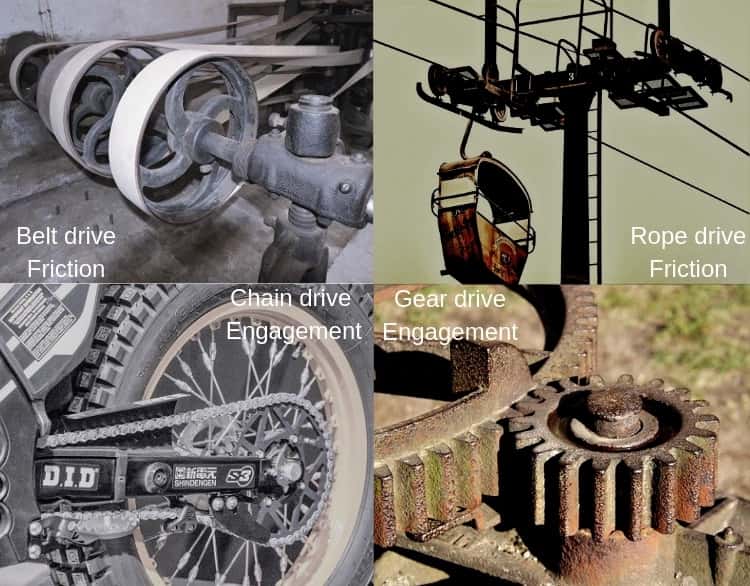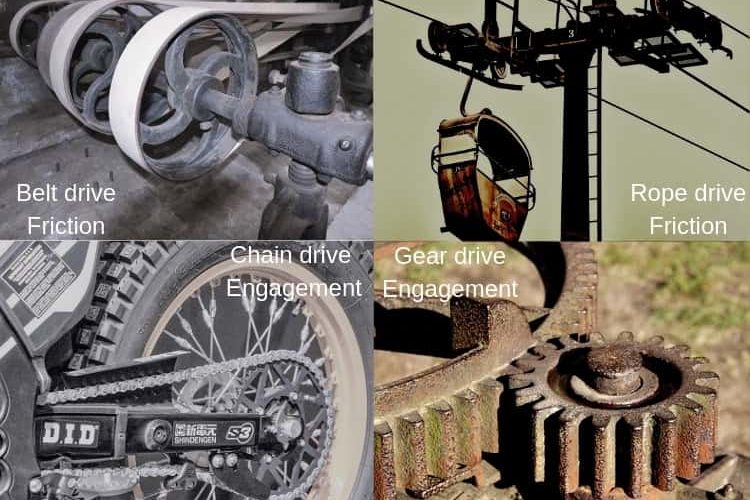Machine is a cluster of mechanisms that requires source of energy to perform certain task in a pre-defined way. Household or industrial machineries are mostly driven with the help of prime movers (such as electric motor, windmill, hydraulic or steam turbine, internal combustion engine, etc.). Usually this prime mover is located away from the machine unit and rotates at higher speed than it is required in machines. Mechanical power transmission system is used to transmit power from this prime mover to the machine unit. Such transmission system serves few basic purposes, such as (i) transmitting motion, torque and power from driver shaft to driven shaft, (ii) reversing the direction of rotation, like clockwise to counter-clockwise or vice versa, and (iii) stepping up or stepping down the speed of rotation.
Mechanical power transmission system consists of four drives and few elements. Four drives are gear drive, belt drive, chain drive, and rope drive. Each of them has certain benefits over others. They directly participate in motion and power transmission and manipulation to fulfil exact requirement. They basically retrieve power from driver shaft and transfer it to the driven shaft. Such drives can be used from low-speed and low-power applications (like mechanical watches, toys, etc.) to high-speed and heavy duty applications (such as marine drives, power plants, vehicle differentials, etc.). On the other hand, power transmission elements include shaft, key, coupling, brake, clutch, sprocket, pulley, etc. These elements are utilized along with drive to facilitate easy and efficient power transmission.

Four drives of mechanical power transmission system can be classified in various ways. One such criteria for classification is the means of power transmission. On this basis, four drives can be categorized into two groups—friction drive and engagement drive. In all such drives where power is transmitted by means of friction are called friction drives. Belt drive and rope drive fall under this category. Their power transmission capability is limited to frictional characteristics of two surfaces under contact. Power loss is also more because of friction. However, they have inherent capability to protect the system from overloading. On the other hand, in engagement drives, power transmission occurs by means of successive engagement and disengagement of two solid parts. Friction force plays no role in such drives. Gear drive and chain drive come under this category. Various differences between friction drive and engagement drive are given below in table format.
Table: Difference between friction drive and engagement drive
| Friction Drive | Engagement Drive |
|---|---|
| Here power and motion transmission occurs by means of friction between two parts. | Here power and motion transmission occurs due to successive engagement and disengagement of toothed parts. |
| Friction drives are prone to slip. So they cannot provide constant velocity ratio. | Engagement drives are free from slip. They can provide constant velocity ratio if other factors are not affecting it. |
| Slip in friction drive can protect the prime mover (such as electric motor) from overloading on driven shaft. | In absence of slip, engagement drives cannot protect the motor from overloading. |
| Friction drives are not suitable for heavy torque or power transmission. | Engagement drives can transmit high torque or power. |
| Friction drives require occasional lubrication. | Engagement drives require frequent lubrication. Even full lubrication is desired in most gear arrangements. |
| Due to inherent friction, loss of power is more. So these drives show comparatively lower efficiency. | In absence of friction, power loss is less. So these drives tend to provide higher efficiency. |
Examples of friction drive:
|
Examples of engagement drive:
|
Means of power transmission: Basic objective of mechanical drives is to transmit motion and power from driver shaft to driven shaft. This power transmission can be realized either by means of friction or by means of mating. Such mechanical drives where motion and power transmission occur by means of friction are called friction drive. For example, friction force between the pulley and the belt helps driving one shaft by retrieving power from another shaft. Apart from belt drive, rope drive also falls under this category. On the other hand, when power transmission occurs by means of successive engagement and disengagement of toothed wheels, then that mechanical drive is classified as engagement drive. Here friction force plays no role in power transmission. For example, in chain drive, mating of teeth of the sprocket with corresponding slot in the chain helps transmitting power. Similarly, gear drive is another example of engagement drive.
Slip and velocity ratio: Ratio of driver shaft speed to the driven shaft speed is called velocity ratio. Various phenomena such as slip, creep, and polygonal effect can change the velocity ratio. A mechanical drive that provides constant velocity ratio is called positive drive. Belt drive, being a friction drive, is prone to slip. Slip in this context indicates any one or both among two cases—(i) the driver shaft is rotating but the belt is not rotating, and (ii) the belt is rotating but the driven shaft is not rotating. Every friction drive is prone to slip and thus it cannot provide constant velocity ratio (non-positive drive). Engagement drives are free from ship; however, they may not necessarily provide constant velocity ratio. Chain drive is not affected by slip but the polygonal effect in chain can hamper velocity ratio in a small extent. Gear drive can be considered as a the only positive drive.
Protection against overloading: Sometimes load on the driver shaft abruptly increases beyond the permissible limit. This may occur due to various reasons such as breakage of cutter, error in calculation, sudden jamming in one part of the machine, etc. Inherent slip in friction drives can protect the driver element (electric motor) from overload in driven shaft. Whenever load increases beyond maximum capable limit, slip occurs automatically. Such isolation facility is not available in engagement drives. Thus there exist high chance that any element may damage permanently. For example, the chain may break or the teeth of the gear may brake catastrophically. In extreme cases, the prime mover may also damage.
Power transmission capacity: Capability of every friction drive is limited by the frictional force acting between two contact surfaces. Accordingly, frictional characteristics of contact surfaces, initial tension, and angle of wrap play crucial role in defining the power transmission limit. Slip occurs inherently whenever this limit exceeds. Thus friction drives are not suitable for heavy power transmission. On the other hand, strength of the concerned elements (such as gear teeth or sprocket teeth) primarily defines the power transmission limit in engagement drives. Friction force has no role here. These drives can be advantageously utilized for heavy power transmission.
Lubrication: Friction drives require occasional lubrication only. In fact, more than desired lubrication is not recommended as it increases slip, which results in unnecessarily fluctuation of velocity ratio and force on the bearings. Heat generation and wear are not significant factors in such drives. On the contrary, engagement drives generate sufficient heat and undergo gradual wear. Thus lubrication is highly desired here. Chain drive requires frequent lubrication; whereas, gear drive mostly require full lubrication. Accordingly maintenance cost is higher in engagement drives.
Power loss and efficiency: Loss of power due to friction and slip makes the friction drives less efficient. Typically belt or rope drive can provide 92 – 96% efficiency for single stage. Engagement drives can provide higher efficiency due to proper lubrication (reduced friction) and less power loss. A chain drive can provide 95 – 97% efficiency; whereas, gear drive can provide up to 99% efficiency in single stage.
Scientific comparison among friction drive and engagement drive is presented in this article. The author also suggests you to go through the following references for better understanding of the topic.
- Design of Machine Elements by V. B. Bhandari (Fourth edition; McGraw Hill Education).
- Machine Design by R. L. Norton (Fifth edition; Pearson Education).
- A Textbook of Machine Design by R. S. Khurmi and J. K. Gupta (S. Chand; 2014).


